The Durston Gear Kakwa 55 Backpack is an ultralight, internal frame pack that weighs just under 2 pounds with a total volume of 55L plus additional external storage. It has a sewn-on hipbelt, load lifters, an aluminum tubular frame, large hipbelt pockets, and a highly configurable hip belt that provides excellent weight transfer to the hips with moderate loads. The Kakwa 55 is made with Ultra 200 which is a waterproof fabric that is considerably more durable than DCF (Dyneema Composite Fabrics) and is a good choice if you hike in sandy or rocky terrain that is highly abrasive when it comes in contact with backpack bottoms.
Specs at a Glance
- Weight (manufacturer): 28 to 31.1 ounces, depending on size (795g-855 g)
- Weight Actual: 28.8 oz in a size medium
- Materials: Ultra 200D, Heavy-duty polyester mesh (Front Pocket), YKK AquaGuard Zippers
- Gender: Unisex, with S-shaped shoulder straps so comfortable for most women
- Pockets: 8 with 2 side pockets (one with a pocket), 2 hipbelt pockets, 2 shoulder strap pockets, and a front mesh pocket.
- Color: Gray
- Type: Internal Frame (3-sided, aluminum wishbone-shaped tubing )
- Hydration compatible: Yes (hydration port only)
- Seam-taped: No
- Sizing: Multiple fixed length torso ranges from 15″-22″; hipbelt lengths are tied to torso lengths (28″-40″)
- Bear Canister Compatibility: BV500 fits into the extension collar, but only vertically below the top of the frame; BV475 fits horizontally in the upper part of the main compartment below the frame, but only vertically below it; BV450 fits horizontally in the bottom of the main compartment.
- Internal Volume: 51-57L depending on sizing
- External Volume: 15L
- Maximum Recommended Load (SectionHiker): 35-40 lbs
- For full specs, see the product page at Durston Gear
Backpack Storage and Organization
The Kakwa 55 is a classic ultralight pack rolltop pack with a front mesh stretch pocket and side bottle pockets, shoulder strap pockets, and hip belt pocket, allowing you to access the essentials you need during the day without having to stop and open up the main compartment to retrieve them. The pack comes with one tier of side compression cords and a Y-strap to secure gear to the top of the pack and has small webbing loops sewn into the seams if you want to add thin cordage to the exterior to haul bulkier objects.
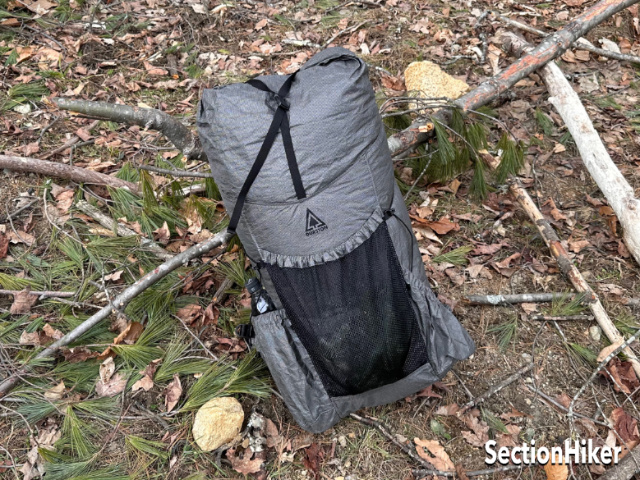
Closed Storage
The main pack bag is a single compartment and holds approximately 55 liters, depending on size (the size small is 51 liters, the size medium is 54 liters, and the size large is 57 liters). This measurement includes the main compartment with two rolls of the extension collar above the frame. Durston Gear claims that there is an additional 15L of storage space in the external open pockets as well. Most mainstream backpack companies (Osprey, Gregory, Deuter, etc.) measure the closed storage differently, only including closed storage up to the top of the frame and not the open storage at all. That said, there is a lot of closed storage space in the Kakwa 55 and plenty for multi-day trips with lightweight gear.
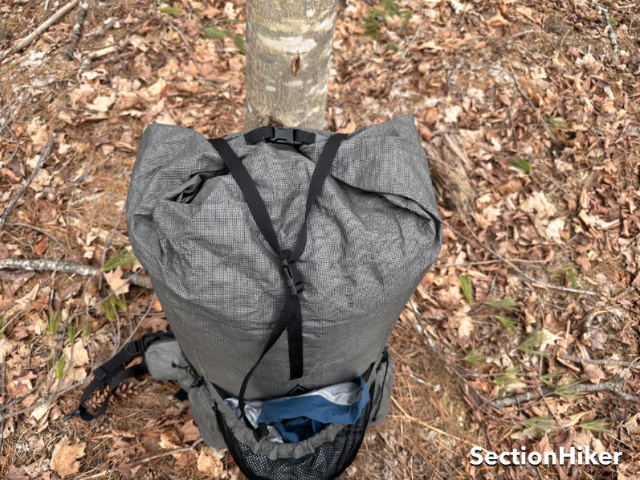
The Kakwa’s main pack bag has quick-release buckles that attach to themselves on top of the pack in the style of a dry bag. There are no additional buckles and webbing on the sides to which you can connect the roll top. I can’t say I’m a fan of roll-top packs built like this because they get hung up easily off-trail when bushwhacking or when winter hiking on trails in deep snow where your pack is in regular contact with the higher branches of trees. I’ve used the Kakwa 55 on several such hikes and its roll-top closure gets consistently snagged in the vegetation overhead: it’s very frustrating. If you don’t hike off-trail or in deep snow, however, it’s unlikely to be a problem. Most backpackers and hikers don’t do either of these things in my experience, although I do both a lot.
The inside of the pack is unadorned, except for a pocket to hold the aluminum frame in place, which is secured closed with a velcro flap. (There is no hydration pocket or place to hang a reservoir although there is a hydration port on the right side of the pack.) In addition to the frame, there’s a thin foam pad, also stored in that pocket to cushion your back. Unfortunately, the pad doesn’t really provide enough cushioning from hard objects and you can feel a bear canister poking you in the back while wearing the pack. The main pack bag also has a tendency to barrel when stuffed tight. You might benefit by putting a few segments of Zlite Sol foam padding up against the frame pocket for more comfort.

Open Storage
The shoulder pockets on the Kakwa 55 are made of a stretchy, Lycra-like mesh with a cordlock and shock cord closure on top. They are a very convenient and accessible way to carry bear spray, phone/camera, satellite messenger, sunglasses, or 16-20 oz water bottles (one-liter bottles are too tall or wide for these pockets). They’re really quite handy.
However, if you prefer to use your own accessory pockets, you can without having to cut the ones that come with the pack off because they are daisy chains running along the outside of the shoulder straps to attach them to. For example, I prefer using the much larger Hyperlite Mountain Gear Shoulder Strap Pocket when I want waterproof storage or the Gossamer Gear Shoulder Strap Pocket and both are easily attached to the Kakwa’s shoulder straps, covering the Lycra pockets that the pack comes with.

The side pockets are asymmetrical, with the right-hand side pocket cut at a diagonal to facilitate easy water bottle access, and the left-hand pocket taller and cut straight across. They fit two Smartwater bottles and even two 32 oz Nalgene bottles, although the fit is considerably tighter with the latter.
Both pockets are cylindrical, with a half-circle of fabric sewn as the bottom of the pocket, level with the bottom of the pack so that they touch the ground when you put the pack down. I’m not sure that’s such a good idea, given the amount of abrasion that will ensue, but Ultra 200 is so much more abrasion-resistant than DCF or Robic Nylon, that it might not matter that much (time will tell.) Perhaps more problematic is that side pockets do not have drain holes, something that Greg Pehrson also noted in his review of the Kakwa 40, where water can leak into the pack seams. We suggest that you use a pack liner whenever you pack up the Kakwa 40 or 55 in a rainy climate. You should do that with any rolltop backpack, anyway.
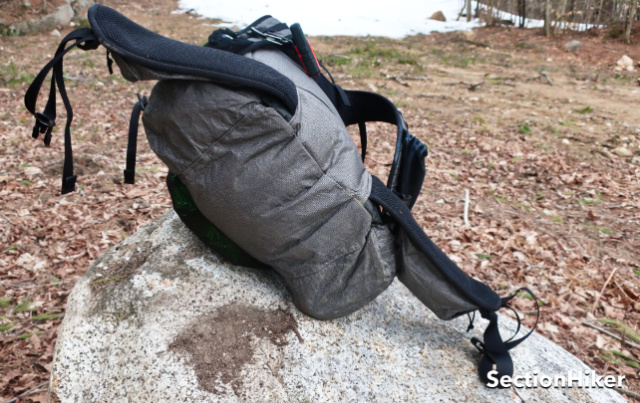
Both side pockets and the front mesh pocket have non-adjustable and non-replaceable elastic that is captured inside a channel of Ultra fabric. The capturing of the elastic means that pocket tension is permanently set; the user can’t tighten or loosen the pockets depending on their contents, which can sometimes be useful when you have to do a long water carry with tall soft bottles.

The taller left-hand pocket is constructed with a double layer of material and has a vertical outer zip creating a small pocket. That outer pocket becomes difficult to use if you overstuff the inner bottle pocket, however, because they share the same volume. It’s not a bad design idea but I found it a little problematic to open and then close while wearing the pack. For example, it would be a good pocket to use to stash something like a wallet that you want to store securely but have easy access to when traveling or in town. But for snacks or extra gloves, my preference is to use the hipbelt pockets or the stretch pockets on the shoulder straps.
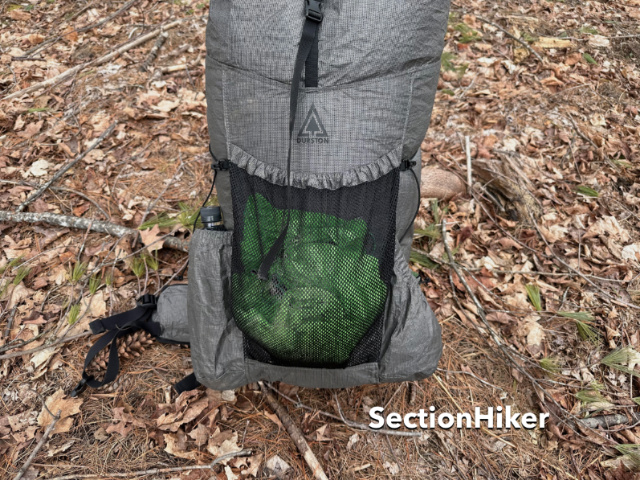
The mesh pocket on the front is a heavy-duty polyester low-stretch mesh that is pleated at the bottom. This means it can expand to hold a Jettboil, a water filter, or wet rain fly/tent but is not droopy when empty. I typically carry layers in a pocket like this instead of stopping to pack them away after a layer change.

The hipbelt pockets are 6” long x 3” tall x 1.5”-2” wide and close with a YKK AquaGuard water-resistant zipper running over the top. The zippers open from front to back and can be easily opened and closed with one hand. I mostly use these pockets to hold snacks, a compass, or a rolled-up map.
Backpack Frame and Suspension
The frame and suspension of the Kakwa 55 pack include the following elements: a wishbone-shaped internal frame tube that’s wide on top but narrows before terminating between the hipbelt wings, a thin internal foam pad, a sewn-on hipbelt with a forward-pull adjustment, S-shaped shoulder straps, and load lifters.

The frame is a hollow aluminum tube bent in an inverted U shape which wish-bones (narrows) when it reaches the small of the back ending on either side of the hipbelt side wings. It’s held in place by two sleeves on each side of the internal frame pocket. There’s really no point in removing it to save weight (4 oz) because it’s the reason why this backpack has such a good load transfer to the hipbelt.

Overall, the hipbelt really works well on this pack. It has a single center buckle, with two independent wings and is tightened by pulling the hipbelt straps forward, called a Sherer Cinch (first introduced by Kelty and designed by Michael Cecot-Sherer, founder of TheTentlab.) The webbing is sewn onto either wing in a sideways V shape to allow for conical tightening (i.e. wider at the bottom, narrower at the top) but each side adjusts with a single pull and there is a just single center buckle to close. This is much simpler and faster to use than packs that requires closing two buckles.
Unlike more modular ultralight packs, the hip belt is sewn to the back of the pack at the point where the frame terminates, providing optimal load transfer to the hips. It doesn’t get any better or more efficient than this. It’s my understanding that Durston Gear tweaked the sizing of the hipbelt slightly between the Kakwa 40 and the newer Kakwa 55 and clarified the sizing parameters so that it’s easier to get a good fit. The only downside of the sewn-on hipbelt design is the length of the hipbelt is tied to torso length which is bound to miss some portion of potential users, like people who are very short and very round.

The shoulder straps are S-shaped, which is better for people with more developed chests/breasts than J-shaped straps because they curve around the chest instead of running directly over it and pressing against it. There is a bar-tacked daisy chain running down the center of each strap, which continues behind the built-in stretch pockets, which are attached at the top and bottom only. The sternum strap hooks to the daisy chains behind the pockets.
The load lifters are attached to a fixed point on the shoulder straps, and to the back panel along the top of the frame. This makes them very effective for repositioning the angle of the pack bag and pulling it closer to your torso and hips. Load lifters are virtually a must-have on framed packs over 50-60L.
External Attachments and Compression
External attachments and compression on the Kakwa 55 are quite simple, consisting of a single tier of static cord and lineloc tensioner on either side of the pack, and a Y-shaped strap of webbing that goes over the top of the pack. There are also a few small loops of grosgrain through which additional attachment points can be rigged up.
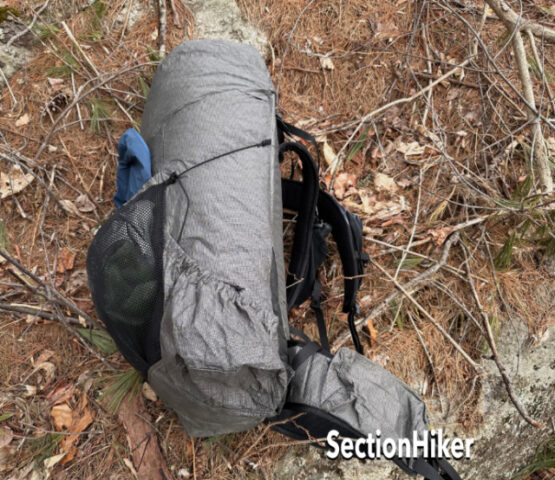
The side compression cord is pretty low utility and is best used to hold long objects against the side of the pack, like a Tenkara rod or trekking poles to keep them from falling out the side pockets. You can also tie things to it like wet socks to dry. Unfortunately, there’s no way to change the angle of the cord so it drops down not up since there are no anchor points on the side opposite the lineloc tensioner to attach the knotted end of the cord. In addition, the problem with a cord like this is that it’s very thin and has a tendency to freeze up in cold weather. It’s also very difficult to strap bulky objects like snowshoes to the sides of the pack, which are best strapped under the top Y strap.
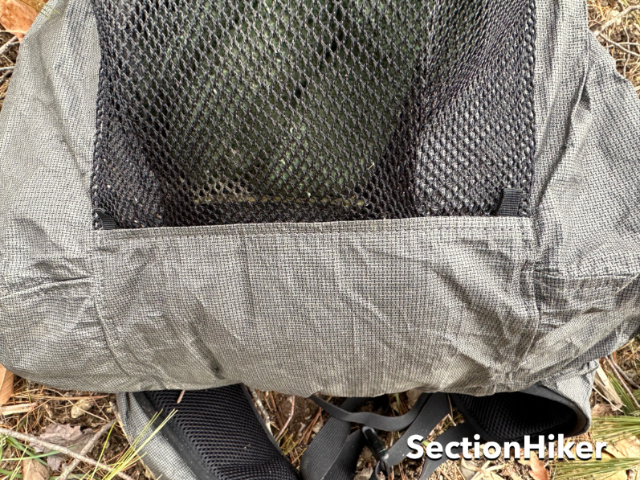
There are two tiny grosgrain loops at the base of the front mesh pocket and along other seams that have enough room to run a very thin cord through. Unfortunately, these loops are so small that a gated buckle won’t fit through them: if you could, you could easily rig up webbing straps all across the exterior of the pack. If I had a vote, that would be an enhancement that would make a big difference in the pack’s utility.

In fact, the only effective way to attach bulky gear like snowshoes, a foam sleeping pad, or a bear canister to the Kakwa 55 is to strap it to the top of the pack using the Y-strap.

Water Resistance
The Kakwa 55 is made with Ultra 200 which is a highly durable waterproof fabric. However, because of the complexity of the seams around the frame assembly, the Kakwa is not seam taped or seam sealed. This means it’s important to use a waterproof liner–a practice that’s a good idea with most any backpack that’s not a legit drybag–in the rain or when packrafting, to keep your gear dry.
Comparable Ultra Backpacks
Recommendation
The Durston Gear Kakwa 55 is a streamlined ultralight-type backpack that’s optimized for thru-hiking and backpacking in three-season weather when you don’t have to strap much bulky or specialized gear on the exterior of the pack. While it doesn’t really have much in the way of compression or external attachment points, the Kakwa has plenty of external open pockets so you can carry all of your daytime essentials without stopping to open the pack. Where this pack really shines, is in the frame and suspension system which does an exceptionally fine job of transferring the load to your hips. We’ve examined some limitations with the pack above, but on the whole, it really is quite a simple and elegant pack to use if you’re looking for a durable lightweight pack made with Ultra 200 fabric.
Disclosure: Durston Gear donated a backpack for this review.
SectionHiker is reader-supported. We independently research, test, and rate the best products. We only make money if you purchase a product through our affiliate links. Help us continue to test and write unsponsored and independent gear reviews, beginner FAQs, and free hiking guides.
